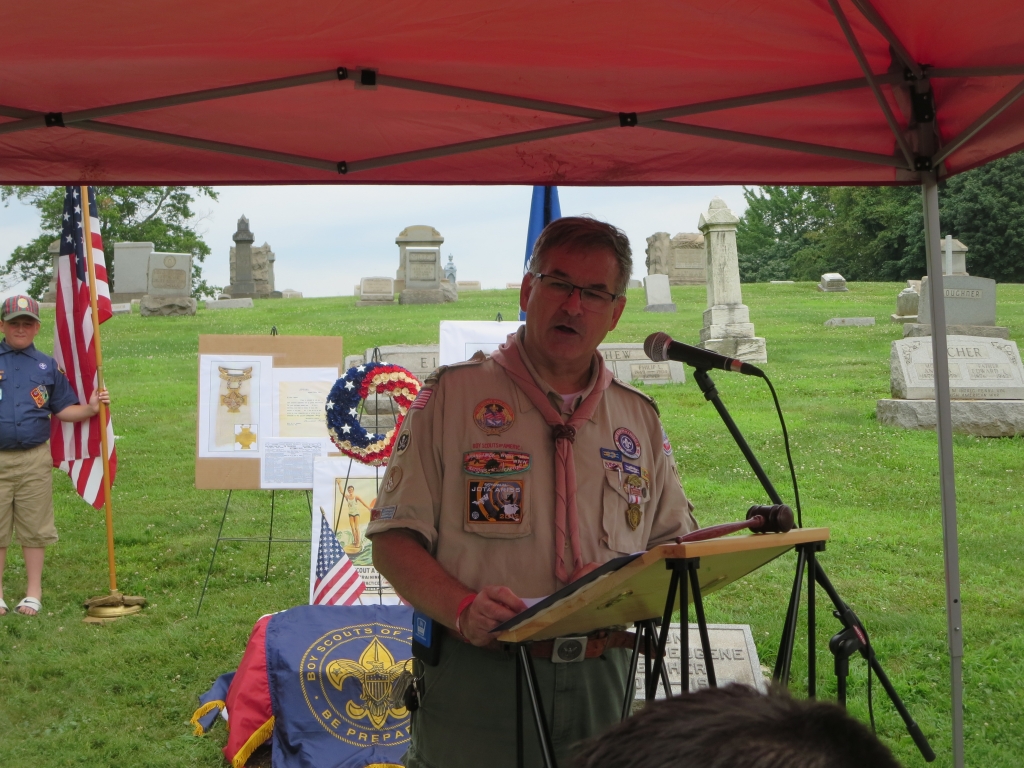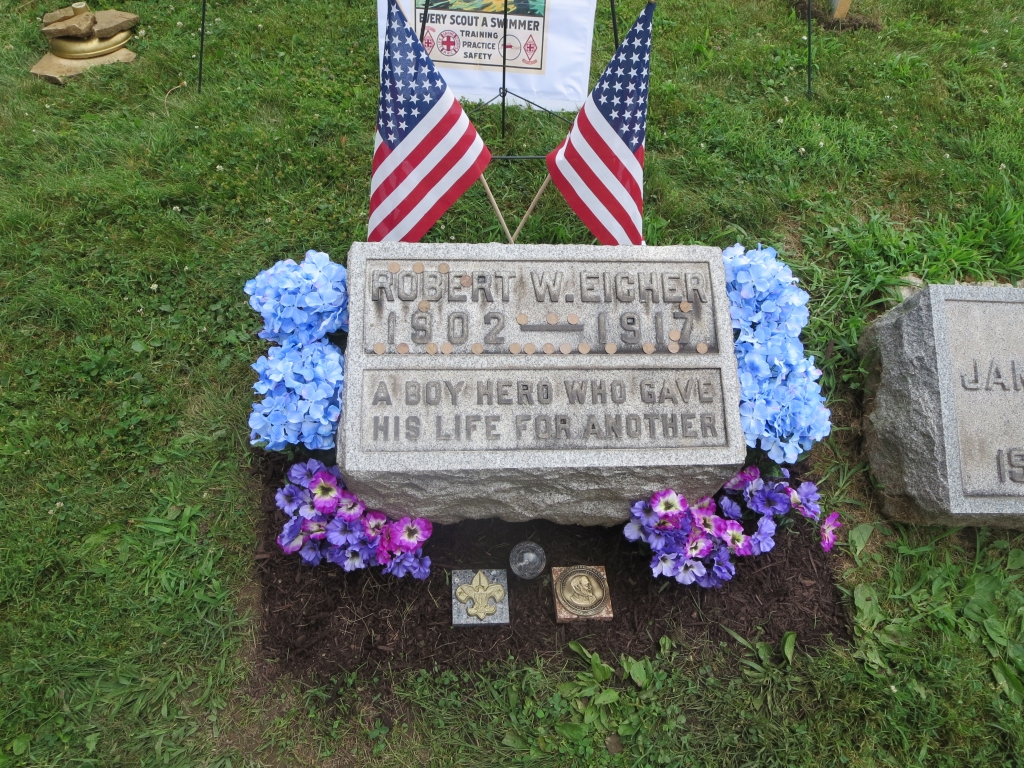
After months of searching—which included two newspaper articles, several interviews, and hours of genealogical research—Boy Scouts of America official Gregory Motta could not solve the mystery of who was leaving bouquets of flowers at the Jeanette, Pa., grave of Carnegie Hero Robert W. Eicher.
Despite his extensive efforts, Motta, who works as a History and Archives committee member and volunteer researcher for the national organization, along with other Boy Scout officials, on July 5, 2018, honored Robert, who died at age 15, with a graveside ceremony that included the placement of a Carnegie Medal grave marker on Eicher’s headstone.
Robert’s original headstone bears the engraved epitaph set by his father, Robert Wilson Eicher. It reads: A Boy Hero Who Gave His Life For Another.
Robert, of Jeannette, Pa., died attempting to help save a girl from drowning in Long Bridge, Pa., in August 1917. According to Hero Fund records, Robert knew the Loyalhanna Creek was dangerous, but still entered the creek fully-clothed and swam toward the girl. Robert sank when he was about 3 feet from her. They both drowned.
During the Hero Fund’s research of Robert’s final act, case investigator A.M. Rowley concluded that Robert was industrious. He was in his second year of high school and had plans to attend college. He also had saved $75 from doing odd jobs, which would amount to approximately $1,800 today.
During the memorial graveside ceremony, a scout historian was on site to answer questions regarding Eicher’s death and also illustrate the influence his actions had on scouting as an evolving movement. Motta spoke of the influence Eicher’s story had on his son and on the Boy Scouts of America as a whole.
“The authors of the 2016 book Running Toward Danger: Real Life Scouting Action Stories of Heroism, Valor and Guts, make the argument, the death of (Eicher and others) had such an impact upon Boy Scouts headquarters that it launched a total program review and revision of all aquatics and lifesaving practices that included a partnership with the American Red Cross,” he said.
Commission President Eric P. Zahren attended the ceremony.
“It’s never, ever too late to honor a hero—a hero is something that lasts forever,” he said.
Leading up to the service, efforts to find relatives of Robert determined that direct descendants of his family are deceased, but that distant cousins of his father and grandfather are thought to be living near Scottdale, Pa.

Still, the lasting and wide-ranging impact of Eicher’s efforts are alive. A century later, his story continues to benefit others, said Motta, most tangibly in the water safety practices and training for members of the Boy Scouts of America and the Robert W. Eicher Memorial Life Ring Buoy Stand located on the north side of the Rappahannock River in Virginia.
The site near Falmouth, Va., and Fredericksburg, Va., has been the location of more than 90 drownings since 1972. After learning of the high number of drownings, Eagle Scout Benjamin Ryan Motta, Motta’s son, developed a plan to build two stands that each hold a life ring, buoy, a throw rope, and instructions on completing a water rescue. A third stand holds about 40 life jackets, free to river visitors.
Benjamin named one of the stands after Robert, who also received the Gold Honor Award from the Boy Scouts.
Although the individual who continues to leave flowers on Robert’s grave remains unknown, the reignited interest and extensive research done by members of Boy Scouts of America, readers of the Tribune-Review, and other volunteers to properly honor a young hero’s bravery is proof of the enduring significance of an instantaneous decision to act selflessly in the interest of others.
Bronze medallions cast in the likeness of the Carnegie Medal are available to families of deceased awardees.
— Abby Brady, outreach intern
Related articles:
- 1967: Two teens save man from attacking bear in remote Idaho forest
- New England priest devotes life to helping those in crisis situations
- From the Archives: Father of 3 returns for fellow miner despite impending blasts
- From the Archives: 1994 – Modest farmhand saves Quebec farmer from attacking bull
- From the Archives: 17-year-old disarms high school shooter in Oregon
- From the Archives: Heroes risk falling to their deaths in cliffside rescue
- From the Archives: 50 years ago ambulance workers save steel workers from second, third explosions
- Heroic ancestors honored over Independence Day weekend
- Hero’s granddaughter marks grave as a gift for mom
- From the archives: Female flight instructor responds to 1958 ’copter crash

